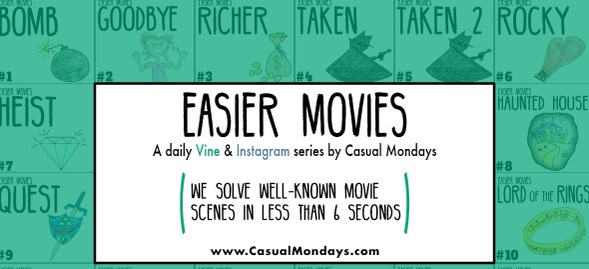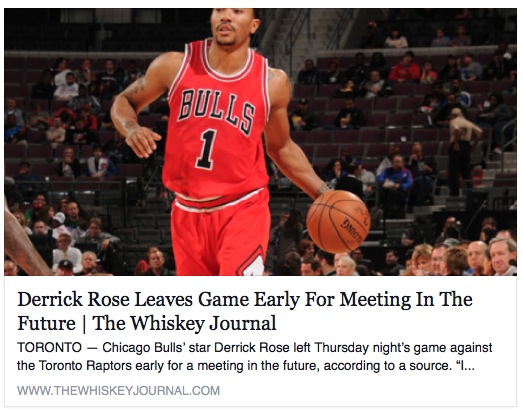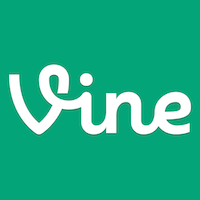The following is part of my Case Study series of articles in which I offer specific advice to a Connected Comedy VIP member based on their personal goals. If you’re interested in being the subject of a Case Study article, email me.
Connected Comedy VIP member Justin Matson is a Los Angeles-based comedian who recently started a video web series with his sketch group Casual Mondays and reached out for some advice about how to make it successful.
Here’s how he described it:
“I just launched a daily Vine and Instagram series called Easier Movies and I’m trying to develop a marketing strategy/define my niche.
Every day we post a six-second video on both Vine and Instagram to our @EasierMovies account. We chose those platforms because we felt they worked well with our short, punchy comedic videos that work well as a loop.
We share the videos to our dedicated Facebook and Twitter pages, as well as our affiliated accounts (our sketch group’s Facebook page and all of our individual pages). We also embed the videos on our website.”
After checking out Justin’s series, I think he’s got a shot at something that could be very successful on his hands. There’s a lot about it that he’s doing right – they’re creating content that fits the platforms they’re using to distribute it, they have a clear audience who is likely to enjoy it (movie fans, and more specifically fans of the movie featured in each individual episode), and they seem committed to producing a large volume of content (daily new episodes) with a level of production (short videos) that make that kind of schedule feasible and not overly expensive.
But there are still a few things that are worth considering to help take the series – or any video series for that matter – to the next level. So, here’s my advice for Justin…
Set Your Goals
As with any project, the first thing to do is have a clear sense of what you hope to accomplish with it. Think about what you want to happen if you’re successful – what do you hope it leads to?
In your email to me, you referenced several goals including building a “huge Vine/Instagram following,” strengthening the acting of group members and giving them a large follower count that might help attract the attention of casting directors on other projects, and using it as a launching pad for your own personal standup and TV projects down the road.
Those are valid goals, but here’s how I would define the goals of this project if I were you. I’d have three main goals – these incorporate your stated goals and expand on them a bit.
Goal #1: Create a video series that functions as a calling card to the industry.
Note that this isn’t just tied to a large follower count – it includes the idea that this series can be a showcase for your writing/acting/producing abilities. Just because you don’t have a million followers doesn’t mean the work isn’t good, and it doesn’t mean there’s not value in doing something.
It only takes one follower who happens to have the power to give you a TV series or cast you in a project to make something a success. And a million followers doesn’t guarantee that any new opportunities will come from it.
In some ways you can think of this series like writing a spec script – the time you put into it gives you something to show to a wide variety of people in the industry that demonstrates your abilities.
It’s great to get a big following for something, but you shouldn’t deem something a success or failure solely on your follower/view count. Setting your goal in this way helps you avoid getting discouraged and giving up too soon.
Goal #2: Build something that has intellectual property value.
What you create may have value in a variety of ways that extend way beyond the initial videos themselves. You should keep that in mind as you develop it – just because something starts as a web series, doesn’t mean that’s all it can be.
Your goal should be to create something that becomes an asset – it’s almost as if you’re investing in real estate. Having more followers increases the value of that real estate, but it doesn’t define the only value of that real estate.
For example, as you do more of these episodes you might find other opportunities to expand the series in other ways – maybe they become a TV series pitch (or part of a bigger TV series pitch), or greeting cards, or t-shirts, or a book. Your goal should be to develop Easier Movies as a piece of intellectual property that can provide value in a number of ways.
Even if it’s just a video series to begin with (which it should be), just keep in mind that ultimately you’re building something that could become much more.
Goal #3: Build something that can be monetized.
This is a distant third goal, but it’s worth having as a goal nonetheless. While I don’t recommend trying to monetize anything when you’re first getting started, you want to keep in mind you can find success with a project like this without necessarily having somebody come pay you to do something with it.
You’re building an audience you can one day monetize directly in a variety of ways – advertising, sponsored content, merchandise, etc. You don’t need to figure out how now, but you should keep in mind that potentially monetizing what you’re creating is a goal for the future because that may influence some of your strategy as you grow your audience.
Choose One Brand To Build
Once you’ve got your goals in place, I’d take a moment to think through exactly what brand you’re trying to build with this series. It sounds like you’ve thought about it some, but it may be a little convoluted because you have several different brands you’re trying to help with this project.
The way I see it, there are a few different potential brands in play here – Easier Movies, your Casual Mondays sketch group, and each of the personal brands of people in the group.
It doesn’t matter which you choose, but I’d strongly recommend choosing ONE brand to primarily associate with this series. The others will benefit regardless, but whatever brand you choose to emphasize should be the one your social accounts are titled and should be the hub for all your activities.
Personally, I’d strongly recommend focusing on the Easier Movies brand – it’s the name of the project and the name that most obviously conveys what this series is about. Because of that, it will be the easiest one to build up (no pun intended).
Obviously, you’d still have the Casual Mondays account and your personal accounts sharing and discussing the series and new videos (you don’t need to hide from it), but all promotion should be to reinforce the Easier Movies brand and social accounts.
It’s tough enough to get people to remember one thing (like “Easier Movies”) without confusing them by referencing other stuff in the posts about the videos. For example, “Check out the new Easier Movies video” is simpler than “Check out the new Easier Movies video by Casual Mondays.”
You want to make it as simple as possible for people to understand what they’re looking at, connect with it, and remember it.
It’s tough to build brands and you only make it tougher on yourself when you try to build multiple brands simultaneously. Pick one and emphasize it consistently.
Choose The Right Platforms
You’re off to a good start in terms of platforms – I think it makes sense to post these videos on Vine, Instagram and Facebook because those platforms should be a great fit for the kind of short videos you’re doing.
But I would recommend adding a couple additional platforms.
First, you should set up an Easier Movies YouTube channel (assuming that’s the brand you go with). Even if you don’t post every video to YouTube individually, it will be helpful for you to have a YouTube presence and you can also upload compilation videos featuring several of your episodes.
Even though you’re making very short videos, YouTube is still the place where most people go to watch video and you should be on there. I’d probably upload each episode there because you also can benefit from YouTube’s search results – especially when you’re making videos about movies that lots of other people are searching for on YouTube.
It’s a little extra effort, but it’s worth the time.
The other platform I’d recommend is buying a web domain specifically for Easier Movies and setting up a website for the series. Again, you don’t have to regularly post a ton of content to it (maybe just embed your YouTube playlist?), but it will help you to have a hub with basic information and an overview of what you’re doing.
You need someplace to send people you meet – especially industry and new fans – that makes it easy for them to get an overview of what Easier Movies is all about.
Plus, it gives you another thing that can be found in search engines and makes you look more professional. It also gives you a place to host an Easier Movies email list signup and you can drive people from all your social platforms there to sign up.
Optimize Your Content
Your content is good and you’ve got a clever concept that’s going to appeal to a specific audience. But there’s a couple things you might want to consider to optimize that content a bit.
I’d recommend focusing on specific movies as opposed to the episodes you’ve posted that have more generic themes. The generic themes confuse the concept a bit – they may be entertaining, but when you’re starting out it’s important to convey a consistent message in what your series is about and I think the generic ones skew that a bit.
Also, the movie-specific ones will be much easier to promote (more on that later) because it’s easy to target those specific audiences as opposed to targeting broader movie fans with the generic episodes.
My other recommendation is to consider doing episodes tied to some new movie releases because you know those movies are going to get a lot of attention each week when they’re released. For example, maybe every Friday or every Monday you do an episode based on a movie that just opened. This would be a way for you to tap into all the conversation online about those movies and get some extra attention for your work.
Promote Your Content
While each episode will be different, here’s four specific strategies I’d recommend for promoting your videos.
Hashtags
I see you’re using hashtags in your posts, but you probably could use them a little better. You want to make sure you use the right relevant hashtags to get your stuff seen.
For example, your Jurassic Park episode should have included Jurassic Park-related hashtags, but also more general film hashtags such as #Movies or #Film and comedy-related hashtags like #Funny #Sketch #Comedy or something like that. You can experiment with them, but you want to use hashtags that people are search for when they’re looking for a specific type of content. Even something like #Dinosaurs or #Trailers might have been worth trying.
Meanwhile, on Facebook you want to use @ tags when referencing movies as opposed to hashtags. When you do that, it will show your post to fans of that movie’s page and dramatically increase your targeted reach as opposed to the hashtag which doesn’t do that.
So rather than using #CitizenKane in your post, you should have tagged the @CitizenKane page to reach those fans.
Facebook Ads
I’m a huge fan of Facebook ads and they will work REALLY WELL for a project like this one. Because what you’re doing has such a specific niche for each episode (fans of the movie referenced in the episode), you’ll be able to target just those people and you’ll get a great reaction.
For example, most Jurassic Park fans will enjoy your episode about Jurassic Park so it will be cheap for you to reach them (because Facebook rewards well-targeted content in ads) and you know the people you reach will likely enjoy your videos.
Plus, video is huge on Facebook right now and pops out in people’s feeds. I’d strongly recommend experimenting with some ads and think you’ll be amazed at how successful they are for you. You never know, but I bet you could get targeted views at around 5 cents per view or less.
But the key is to run the ads only targeting fans of the movie in the episode – go specific and narrow, not broad.
Reach Out To Movie Blogs
Another benefit of the specific niche of your content is it should be easy to find blogs who might share your stuff. There’s a ton of movie blogs out there and you should reach out to them and tell them about what you’re doing.
Besides pitching them your content, you could offer to create some episodes specifically for them – maybe they would agree to post a series of episodes as a list where they could get a big content hit and you would get attention and views for the videos.
For example, you could pitch them the idea of creating a series of episodes about Steven Spielberg films that they could compile into a post titled “5 Spielberg Films In 5 Seconds Each” or something like that.
You can also reach out to popular movie podcasts and see if you can get booked as a guest or start interacting with them online. There are lots of possibilities, but you definitely want to start building relationships with the online movie fan community because they can help you reach a bigger audience.
Build Your Community
As you’re introducing more people to your content and growing your audience, you’ll also want to explore ways to turn that audience into a more active community. Again, you’ve got a great opportunity here since your concept lends itself to lots of interesting ways people could participate and it’s based around something that people naturally love to discuss.
For example, here’s a few things you might want to try:
Ask fans to suggest movies for you to feature in episodes.
Let fans create their own versions of Easier Movies which you feature on your site/channel.
Ask fans to send you Easier Movies scripts that you can then bring to life.
Create a contest where some of your Easier Movies crew create two different episodes based on the same movie and let the viewers vote to determine which one is their favorite – you could then build ongoing rivalry storylines around some of these amongst the people making them.
Offer local fans the chance to appear in one of your episodes.
On Twitter or Facebook, create text-based prompts that allow people to play along, similar to what happens with Hashtag Wars. Maybe something like #EasierMovieTitles?
There are tons of ways you can create opportunities for fans to interact with your series and feel a part of it so you should keep that in mind as you move forward and experiment with some of them.
One other note about this kind of community involvement – the added benefit of doing this is that any time you do an episode that a fan has some involvement with, it’s a safe bet that they’ll share it with their friends and spread the word.
More fan involvement equals more exposure for your series.
One More Important (But Slightly Less Fun) Thing To Consider
Whenever you start a project with a group of people, it’s worth having a quick conversation up front about who exactly owns what it is that you’re building.
You don’t need to formally get lawyers involved, but it’s worth talking it through and putting something in writing amongst yourselves, before things start to (hopefully) take off.
No matter how good your relationship is with the people you work with, issues may come up down the road and you never know what’s going to happen as your project gets more successful and more complicated.
Also, if you’re lucky enough to get industry attention and somebody wants to do something with what you’ve created, the first thing they’re going to want to know is who owns Easier Movies and who makes the decisions on its future.
For example, what happens if somebody wants to turn it into a TV series but only wants to use two of the group members on air? Or, what happens if somebody wants to buy the concept but not use any of the group members on air?
I have no idea if you guys have had a conversation about this or not at this point, but my strong recommendation would be that you get on the same page with everybody involved so it’s clear who “owns” Easier Movies and whatever everybody’s participation entitles them to in it.
It may seem like an unnecessary conversation to have at this point, but making sure you’re on the same page when you start something will make it infinitely easier to succeed later on down the road.
And I know this because I’ve seen first hand what can happen when a bunch of talented people start working on a project and then suddenly the whole world gets interested in them – it can get real complicated, real fast.
Good luck with the series – I’ll be watching and can’t wait to see where it goes!
READ THIS NEXT: How To Decide Where To Post Your Comedy Videos





















